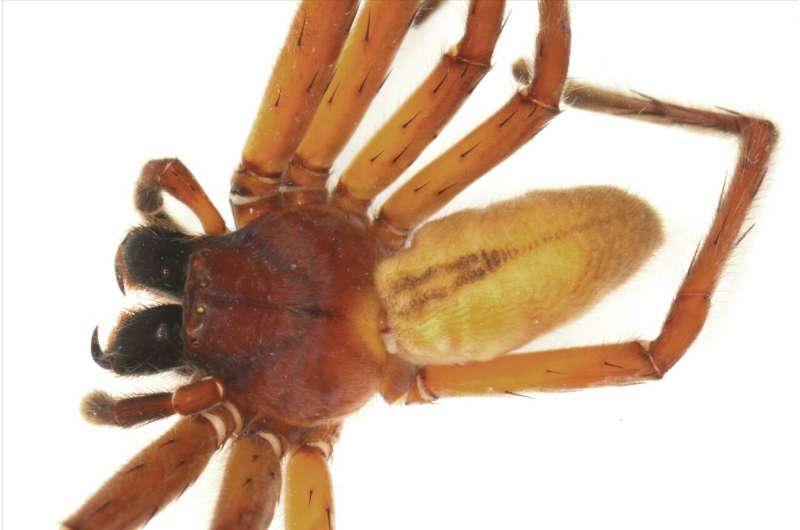Rhitymna gerdmangel. Credit: Senckenberg
Senckenberg scientist Dr. Peter Jäger has described four new species in the huntsman spider family. One of the newly discovered animals reveals a surprising specialization: It makes its home inside of bamboo. To enter the plants, the palm-sized, eight-legged creature relies on the help of other animals. This is only the second species of spider known to science whose ecology is closely tied to bamboo. The study was published today in the scientific journal Zootaxa.
Bamboo has a special ecological, economic, and cultural importance, particularly in Asia. Among others, the giant woody grass is used in regional furniture manufacture and home construction, textile production, and as fuel source. "In addition, bamboo also plays a significant role for the fauna," explains Dr. Peter Jäger of the Senckenberg Research Institute and Natural History Museum in Frankfurt, and he continues: "For many years, my colleague Dr. Damir Kovac has been studying the faunal communities in Southeast Asia associated with bamboo. During his expeditions, he repeatedly noticed spiders that utilized the plant as a 'one-room apartment.'"
In the process of revising the spider genus Rhitymna, Jäger took a closer look at these arachnids and was soon able to identify them as a hitherto undescribed species. "The spider's unusual lifestyle – inside of bamboo – has likely been the reason why this species escaped detection until now. As a rule, we arachnologists are not in the habit of sawing open bamboo canes," says Jäger jokingly. To date, the new huntsman spider, described as Rhitymna gerdmangel, has only been found in two locations – in northern Thailand, and near Kuala Lumpur in Malaysia. "The discovery sites lie approximately 1,800 kilometers apart from each other. Therefore, it can be assumed that this spider also inhabits other areas with bamboo stands but has simply been overlooked thus far," adds the arachnologist from Frankfurt.
However, for Jäger, the true surprise comes with the spider's specialization on hollow bamboo. To get inside these stable hiding places, the eight-legged creatures depend on the help of other animals in the neighbourhood. They are aided by the activities of the bamboo woodpecker as well as beetles hatching from inside the bamboo. The larvae of the latter feed on hard-to-digest plant material, pupate, and eventually gnaw their way out of the bamboo canes as adult beetles. "Lucky for the spiders, who can subsequently move into these protected cavities, which they only leave for their nocturnal hunting forays," comments Jäger.
"Our discovery in the bamboo indicates that the 48,000 species of spiders known around the world to date only represent a fraction of the group's actual diversity," adds Jäger in closing.
Journal information: Zootaxa























